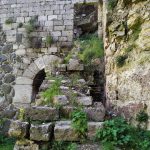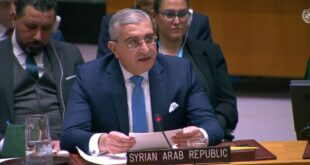Damascus, SANA-A report by Russian Sputnik Agency released images posted by Syrian media, including the Syrian Arab News Agency (SANA), showing progress in the restoration of the Krak des Chevaliers, an ancient medieval castle situated outside the city of Homs, western Syria.
The report talked about the castle, which dates back to the 11th century, and was rebuilt between the 1140s-1170s by Catholic Christians, known as the Knights Hospitaller, and which was damaged in Syria’s war against 21st century barbarians – foreign fighters, mercenaries and extremists.
Terrorists captured the castle in the spring of 2012, turning it into a staging area for terrorists flooding into the country, and holding it until 2014 before being kicked out by the Syrian Army, according to the report.
During its occupation, the castle was subjected to the desecration of its ancient walls as terrorists blasted down doorways and staircases, littered halls with broken masonry, set fire to its heart – the Knights Hall, and looted its ancient artifacts, the report elaborated.
Despite the terrorists’ attempts, and thanks to the Syrian government forces’ careful effort to avoid damaging the ancient artifact during their operation to retake the castle, the ancient site stood firm.
The report released photos showing the progress of the restoration work, from the reconstruction of ancient doorways and doors, to the rebuilding of stone stairwells, roofs, ancient arches, to efforts to save remnants of the castle’s priceless ancient mosaics. Castle Director Eng.
Hazem Hanna said work was underway to complete the third phase of a Memorandum of Understanding signed in 2021 between the General Directorate of Antiquities and Museums and the Syriac Orthodox Patriarchate, including plans to strengthen the northern wall of the southern stable building overlooking the moat.
Work has already seen the restoration of the façade of the corridor in the inner castle yard, the entrance to the Knight’s Tower, and multiple staircases, and the creation of new insulation and rainwater drainage systems to shield the castle from the elements. Syrian and Hungarian archeologists have also been working together at the castle, documenting the remnants of ancient stone decorations and systematizing them, presumably to allow for future restoration work. Designated a UNESCO World Heritage site in 2006, the Krak des Chevaliers has been a part of Syrian history for nearly 900 years, witnessing fierce fighting during the Crusader period, and housing an Ottoman Imperial garrison as part of the Tripoli Eyalet.
The castle became a major tourist attraction during the French occupation of Syria and Lebanon between the 1920s-1940s, and was described by T.E. Lawrence, aka Lawrence of Arabia, as “perhaps the best-preserved and most wholly admirable castle in the world.”
The report noted that as part of independent Syria, the castle would attract up to five million people every year, many of them coming to the country specifically to see this ancient architectural marvel with their own eyes. Syria began reconstruction of the castle in 2018. It is one of dozens of major historical monuments and artifacts which has been fortunate enough to survive the terrorist onslaught, and to receive resources and support for restoration work. Syria is home to some of the oldest continuously inhabited settlements in the world, with Damascus, Aleppo, and Homs settled between the early 3rd and 2ndmillennium BC.
Manar Salameh/ Ruaa al-Jazaeri
 Syrian Arab News Agency S A N A
Syrian Arab News Agency S A N A










